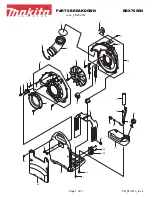
12
•
The
INPUT LEVEL
rotary knobs adjust the input signal levels on the LEFT (PRI) and RIGHT
(REF) channels. Above each knob is a tricolor Level LED that indicates input signal
strength. Adjust the LEFT and RIGHT
INPUT
controls so that the tricolor
LEVEL
LEDs
display green or occasionally yellow. Do not allow the input level to go into the red region or
distortion may occur.
•
The
CLEAR
button is used to restart the adaptive filters as deemed necessary. This function is
particularly useful if the filter has “crashed” and produces only garbled noise on its outputs (an
extremely rare event when the Crash Detect feature is enabled). Another example of when to
press the
CLEAR
switch is when the audio scene changes suddenly, requiring a new filter
solution; this may occur when the microphone is moved, or when processing tape recorded
conversations that occurred at different locations.
•
The
MODE
rotary switch selects the desired filter by rotating the knob to the desired filter.
The MicroDAC IV will automatically reset and load the filter whenever the MODE setting is
changed. Notice that one of the filter settings is labeled
BYPASS
; this setting simply routes
the input signal to the output without any processing.
Now refer to the Figure 1 illustration of the rear panel features, described as follows:
•
The
POWER
connector mates to a 2.1 mm barrel plug. To power the unit connect the external
AC power adapter to the
POWER
connector. Alternatively, 12VDC power can be directly applied
using a specially-wired adaptor; the wiring guide for the plug is silk-screened on the rear panel.
•
The MicroDAC IV communicates with the computer’s serial port via the
RS232
connector. The
supplied Windows software programs the MicroDAC IV over this serial link.
•
An
EXTERNAL CLEAR
jack can be used to remotely clear the adaptive filters via contact
closure (shorting the two terminals together). This operates in an identical manner to the front
panel
CLEAR
button.
•
The 44.1KHz
DIGITAL OUTPUT
is an S/PDIF format digital data stream that is driven
directly from the signal processor output. This data is clocked at the same rate as CD
players, which allows the digital processed signal to be recorded directly to a DAT or CD
recorder.
•
The
ANALOG OUTPUT
RCA jacks provide the MicroDAC IV’s filtered output in analog form.
These line level signals can be directly connected to a copying tape recorder or loud speaker
amplifier, if desired. If the MicroDAC IV is not powered, the
ANALOG INPUT
signals are
automatically routed to the
ANALOG OUTPUT
jacks.
•
The
ANALOG INPUT
RCA jacks are the MicroDAC IV’s inputs. These line level inputs allow
the audio source to be input for filtering.












































